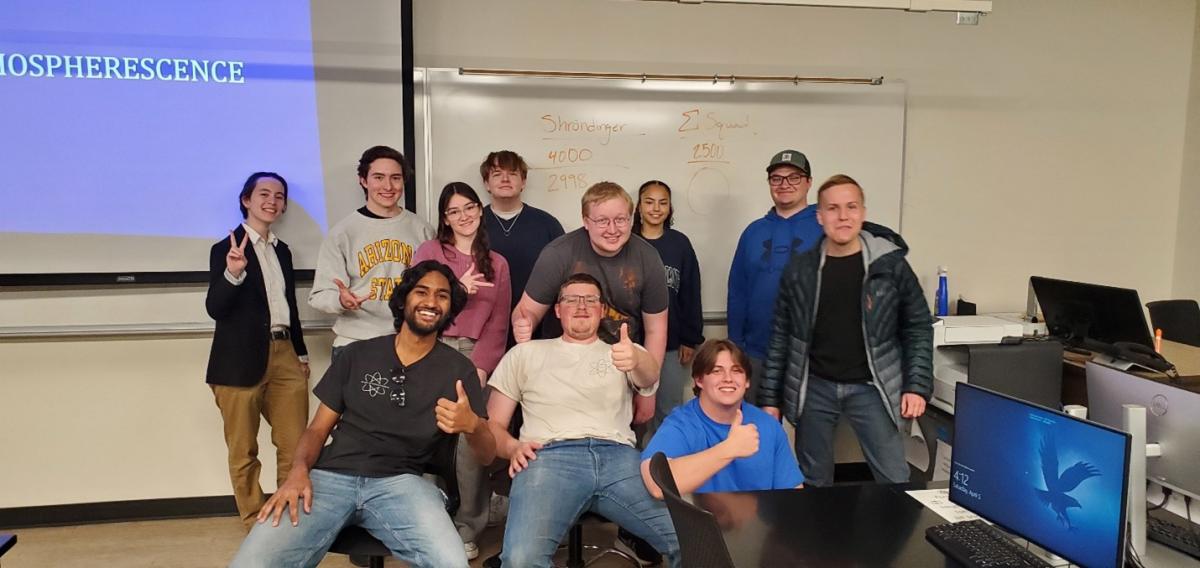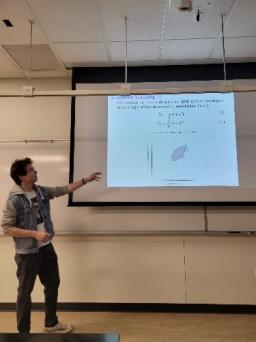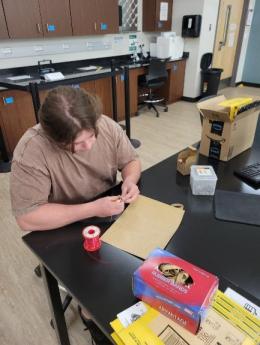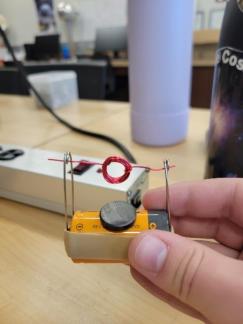SPS Zone Meeting
April 4, 2025 to April 5, 2025
Meeting host: By:Bailey Wolf
SPS Chapter:

SPS Zone 16 Zone Meeting Report
Report:
- New Mexico University and Arizona State University attended the meeting at Embry-Riddle, along with members from Embry-Riddle.
- 3 members from NMU and 4 members from ASU, as well as 9 members from Embry-Riddle attended the meeting: so, 16 total.
- At the meeting, we talked about who would host the meeting next year; ASU is the leading candidate for this, but NMU also said they would host it if ASU failed to do so.
The Zone 16 zone meeting started on Friday, April 4th. I was coordinating with the president of the University of New Mexico’s president on when the three of them were arriving at the hotel that we got them. Once this was done, I also told them of the amazing things to do on Whiskey Row in downtown Prescott. Then, we all got a nice amount of sleep, and started the actual zone meeting activities at 9:30 A.M. We met in one of our engineering buildings on campus. The students from ASU drove up the day of the meeting, and they beat all of us to the building in the morning! The students from New Mexico got a little confused on finding the building on campus, so I had to guide them over the phone to the destination. In the end, we all managed to get on campus and start the meeting. We introduced ourselves, and then had the visitors introduce themselves to us. Once this was done, we took a tour around the campus. The campus itself was thriving that day, because of Preview Day going on (the day for incoming students to learn more about the university). We showed them some of our more important buildings, including the Hazy Library, the AXFAB building, the STEM building, and AC-1. All the visitors were surprised that we have our own planetarium in the STEM building; mostly because our planetarium is the largest and one of the only ones in Arizona. After we concluded the campus tour, we started our research presentations. This was a section of time where the visitors and anyone from our chapter of SPS could present their research or a project they were working on. We had two presenters from Arizona State: Olivia and Jake. No one from New Mexico had any research to present. The first person to go was Hailey from Embry-Riddle; she did a presentation on Quantum Information Theory for the REU she did at UIUC (University of Illinois Urbana-Champaign). I especially enjoyed this one since I have also done a directed study in that field.  After her, Isaiah from Embry-Riddle presented his research on quantum discord of graviton detection. I was very lost with this one, as I have no experience in the field. Next, Blake from Embry-Riddle presented his start-up project that he’s working on with gravitational waves. After this, Brandon from Embry-Riddle followed Blake’s footsteps with his project of detecting gravitational waves, but he also has a Cavendish pendulum-type setup for doing so. Then, Jake from ASU gave his presentation on modelling globular clusters in simulated dwarf galaxies. This was a very interesting project for me, because I’m an astronomy major, and I love doing analysis on large amounts of data, like these simulations. Next, Olivia from ASU gave her presentation on constraining WIMP dark matter with spheroidal dwarf galaxies. I’m not familiar with WIMPs and dark matter, but it was still a great presentation by her. After this, my president Charles and Dwight, the AZC and ZC for Zone 16 respectively, talked about the upcoming Physics and Astronomy Congress being held in Denver later this year. They both encouraged all of us to participate in the video contest and other such things that can give us funding to go to the congress. After this, Dwight gave us a presentation on some of the stuff he does at Sandia National Laboratory. After all of the presentations were over, I decided that it was best for people to get a break and stretch their legs.
After her, Isaiah from Embry-Riddle presented his research on quantum discord of graviton detection. I was very lost with this one, as I have no experience in the field. Next, Blake from Embry-Riddle presented his start-up project that he’s working on with gravitational waves. After this, Brandon from Embry-Riddle followed Blake’s footsteps with his project of detecting gravitational waves, but he also has a Cavendish pendulum-type setup for doing so. Then, Jake from ASU gave his presentation on modelling globular clusters in simulated dwarf galaxies. This was a very interesting project for me, because I’m an astronomy major, and I love doing analysis on large amounts of data, like these simulations. Next, Olivia from ASU gave her presentation on constraining WIMP dark matter with spheroidal dwarf galaxies. I’m not familiar with WIMPs and dark matter, but it was still a great presentation by her. After this, my president Charles and Dwight, the AZC and ZC for Zone 16 respectively, talked about the upcoming Physics and Astronomy Congress being held in Denver later this year. They both encouraged all of us to participate in the video contest and other such things that can give us funding to go to the congress. After this, Dwight gave us a presentation on some of the stuff he does at Sandia National Laboratory. After all of the presentations were over, I decided that it was best for people to get a break and stretch their legs.  So, we walked over to the STEM building and into the planetarium, where we watched a free 40-minute show hosted by Embry-Riddle. This show was titled Across the Observable Universe, and it was a show about the boundaries of what we see and know about our solar system, galaxy, and well beyond our galaxy into other galaxies. I personally have never seen this show, and I thoroughly enjoyed it, as well as the visitors. After this, I figured that everybody needed a break, so we had lunch together. I catered from Jersey Mike’s for lunch. Upon going back to the room that I booked, it turned out that we apparently got kicked from our room. This was a minor inconvenience, and we just moved into the next room. When we were having lunch, I talked with the students from ASU and UNM about their experiences with classes, and what was different from us and such. I found out that astrophysics majors at ASU have quite a few more choices of classes to take than me, which makes sense considering ASU is a much larger university than ours. I realized that we have an observatory that can be run by the students, and that neither ASU or UNM had anything like that, so that was cool. During lunch, one of the students from UNM told me that they had a family matter come up, so they had to leave tonight instead of tomorrow morning. This changed our plans slightly, as we did not need to meet up Sunday morning as well, since the students from ASU were also leaving on Saturday. Nonetheless, we continued with our activities. After lunch, we went over to a lab in the STEM building to have a demo show. This was led by our outreach coordinator, Logan. We spent time building a motor out of a battery, a rubber band, two paper clips, a wire, and a magnet.
So, we walked over to the STEM building and into the planetarium, where we watched a free 40-minute show hosted by Embry-Riddle. This show was titled Across the Observable Universe, and it was a show about the boundaries of what we see and know about our solar system, galaxy, and well beyond our galaxy into other galaxies. I personally have never seen this show, and I thoroughly enjoyed it, as well as the visitors. After this, I figured that everybody needed a break, so we had lunch together. I catered from Jersey Mike’s for lunch. Upon going back to the room that I booked, it turned out that we apparently got kicked from our room. This was a minor inconvenience, and we just moved into the next room. When we were having lunch, I talked with the students from ASU and UNM about their experiences with classes, and what was different from us and such. I found out that astrophysics majors at ASU have quite a few more choices of classes to take than me, which makes sense considering ASU is a much larger university than ours. I realized that we have an observatory that can be run by the students, and that neither ASU or UNM had anything like that, so that was cool. During lunch, one of the students from UNM told me that they had a family matter come up, so they had to leave tonight instead of tomorrow morning. This changed our plans slightly, as we did not need to meet up Sunday morning as well, since the students from ASU were also leaving on Saturday. Nonetheless, we continued with our activities. After lunch, we went over to a lab in the STEM building to have a demo show. This was led by our outreach coordinator, Logan. We spent time building a motor out of a battery, a rubber band, two paper clips, a wire, and a magnet.  By sanding the wire down, and curling it up into a circle, one can create a magnetic field between the wire and the magnet on the battery, which will in turn spin the wire. This was a fun activity, because none of the visitors had seen this demo before, and it was fun to watch the wire spin around itself. Then, once everyone had made their motors, we split the people in four groups, where we then rotated around the room, looking at four separate demos. The first demo was a bike wheel with handles, where you can show that if you stand on a rotating platform, angular momentum will pull you one way if the bike wheel is spinning that way. The visitors loved doing this one, because it’s fun to hold onto a wheel and have it spin you. We also tried this by holding two separate weights in our arms and pulling the weights in while spinning. Since the radius between the weights decreases, the angular momentum will in turn get larger, making you spin faster. Another demo we had was one on space-time curvature. We had a large square with cloth in the middle, and we put weights in different places on the cloth, to create massive objects in space that will curve space and time. Then, we threw “objects” (marbles) around the weights, which showed how the weights curve the objects’ paths. This is a very fun way to explain space-time curvature, and it reminds me of the circular bowls that you would roll pennies into until they hit the bottom. The third demo we had is one called the “fire syringe”. This was a demo about how combustion happens in high-pressure environments. We had a pump, that we put a small piece of a Q-tip in and then pushed the pump down very fast on the Q-tip piece. This increased the pressure very abruptly, which in turn increased the temperature inside the tube rapidly and set the Q-tip piece on fire. This demo is a fun way to explain the effects of the ideal gas law. The last demo we showed was the Van de Graaff generator. This is basically a big ball of electricity that creates static electricity. It was fun to mess around with it by creating chains of electricity between people, and shocking others. Note that the energy created is not enough to shock someone badly. When we finished the demos, we went down to the optics lab classroom and looked at one of the demos that our professor, Dr. Smith, had set up for Preview Day. He calls it the cloud chamber, because using dried ice, you can detect bands of radiation and ionized particles inside. It was fun to watch the visitors stare into the chamber and watch wisps of radiation and particles go by. At this point, it was getting late in the day, and the visitors from UNM had to drive back. So, we sent them off and thanked them for coming. The students from ASU wanted to head back tonight as well, but we did one last thing. We played a game of SPS Jeopardy. Since we played the newest version a couple of months ago, we decided to take a trip back in time and play the 2018 version. It turns out that the ASU students knew a lot more information about general physics than the Embry-Riddle students, as they beat us comfortably in it. With this done, the ASU students decided they needed to get back to Phoenix, so we took a group photo and sent them off on their way. Everyone had a great time at the zone meeting this year, and I can’t wait to hopefully attend next year’s meeting as well!
By sanding the wire down, and curling it up into a circle, one can create a magnetic field between the wire and the magnet on the battery, which will in turn spin the wire. This was a fun activity, because none of the visitors had seen this demo before, and it was fun to watch the wire spin around itself. Then, once everyone had made their motors, we split the people in four groups, where we then rotated around the room, looking at four separate demos. The first demo was a bike wheel with handles, where you can show that if you stand on a rotating platform, angular momentum will pull you one way if the bike wheel is spinning that way. The visitors loved doing this one, because it’s fun to hold onto a wheel and have it spin you. We also tried this by holding two separate weights in our arms and pulling the weights in while spinning. Since the radius between the weights decreases, the angular momentum will in turn get larger, making you spin faster. Another demo we had was one on space-time curvature. We had a large square with cloth in the middle, and we put weights in different places on the cloth, to create massive objects in space that will curve space and time. Then, we threw “objects” (marbles) around the weights, which showed how the weights curve the objects’ paths. This is a very fun way to explain space-time curvature, and it reminds me of the circular bowls that you would roll pennies into until they hit the bottom. The third demo we had is one called the “fire syringe”. This was a demo about how combustion happens in high-pressure environments. We had a pump, that we put a small piece of a Q-tip in and then pushed the pump down very fast on the Q-tip piece. This increased the pressure very abruptly, which in turn increased the temperature inside the tube rapidly and set the Q-tip piece on fire. This demo is a fun way to explain the effects of the ideal gas law. The last demo we showed was the Van de Graaff generator. This is basically a big ball of electricity that creates static electricity. It was fun to mess around with it by creating chains of electricity between people, and shocking others. Note that the energy created is not enough to shock someone badly. When we finished the demos, we went down to the optics lab classroom and looked at one of the demos that our professor, Dr. Smith, had set up for Preview Day. He calls it the cloud chamber, because using dried ice, you can detect bands of radiation and ionized particles inside. It was fun to watch the visitors stare into the chamber and watch wisps of radiation and particles go by. At this point, it was getting late in the day, and the visitors from UNM had to drive back. So, we sent them off and thanked them for coming. The students from ASU wanted to head back tonight as well, but we did one last thing. We played a game of SPS Jeopardy. Since we played the newest version a couple of months ago, we decided to take a trip back in time and play the 2018 version. It turns out that the ASU students knew a lot more information about general physics than the Embry-Riddle students, as they beat us comfortably in it. With this done, the ASU students decided they needed to get back to Phoenix, so we took a group photo and sent them off on their way. Everyone had a great time at the zone meeting this year, and I can’t wait to hopefully attend next year’s meeting as well!
